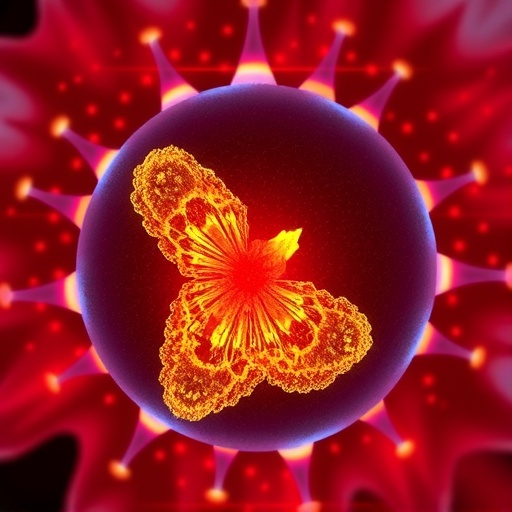In a groundbreaking advancement for cancer therapeutics, researchers at Moffitt Cancer Center have unveiled the first clinical evidence supporting the efficacy of a RAS inhibitor in the treatment of NRAS-mutant melanoma, a notably aggressive and treatment-resistant form of skin cancer. This discovery paves the way for a potential paradigm shift in how this challenging malignancy could be managed. The investigational agent, daraxonrasib (RMC-6236), alongside its preclinical analogue RMC-7977, has demonstrated the ability to directly inhibit RAS proteins in their active state. By targeting NRAS, HRAS, and KRAS proteins, daraxonrasib effectively blocks downstream signaling pathways crucial for tumor proliferation, survival, and immune evasion, which have historically rendered RAS a challenging target for drug development.
The complexity of NRAS-mutant melanoma lies in its resistance to many existing treatments. Unlike BRAF-mutant melanoma patients, who benefit from diverse FDA-approved targeted therapies, those with NRAS mutations face a dearth of options beyond immune checkpoint inhibitors. Unfortunately, a significant portion of these patients either do not respond to immunotherapies or eventually develop resistance, underscoring the critical need for novel, effective targeted approaches. Daraxonrasib’s development addresses this gap head-on by focussing on RAS proteins locked in their constitutively “on” configuration, a state that perpetuates uncontrolled cellular growth and immune suppression within the tumor microenvironment.
At the molecular level, RAS proteins function as binary switches that regulate key signaling cascades such as the MAPK pathway, which promotes malignant behaviors in cancer cells. Mutations in NRAS result in its persistent activation, circumventing physiological control mechanisms. Daraxonrasib binds specifically to these active RAS forms, disrupting their signal transduction capabilities. This inhibition halts tumor cell proliferation and induces apoptotic cell death, but perhaps even more compelling is the drug’s capacity to modulate the tumor immune microenvironment. Laboratory models revealed that daraxonrasib not only diminishes cancer cell viability but also enhances infiltration by activated T lymphocytes, particularly CD4+ and CD8+ subsets, which are crucial for recognizing and eradicating tumor cells.
Further examination in preclinical settings demonstrated that daraxonrasib’s antitumor effects are heavily reliant on the host immune system. Treatment led to a notable decrease in myeloid-derived suppressor cells, a population of immune cells known to facilitate tumor immune escape. When these suppressive cells were depleted or when T cells were experimentally removed, the efficacy of the RAS inhibitor was significantly diminished or abolished, indicating that daraxonrasib functions synergistically with the immune system. This dual action — direct tumor inhibition and immune activation — enhances the drug’s potential for durable therapeutic responses, a feature that could markedly improve patient outcomes in NRAS-mutant melanoma.
Clinical translation of these findings was marked by the treatment of two patients with advanced NRAS-mutant melanoma in an early-phase trial involving daraxonrasib. Remarkably, one patient experienced a complete response, with no detectable tumor on imaging studies, while the other achieved a substantial partial response. These outcomes are unprecedented in the context of RAS inhibitors for this melanoma subtype, signifying a monumental breakthrough in targeted cancer therapy. Such results underscore not only the drug’s promise but also validate the concept of targeting active RAS proteins as a viable therapeutic strategy.
The journey toward making daraxonrasib widely available, however, remains in its nascent stages. Currently, the drug is undergoing a phase 1 clinical trial designed to evaluate safety, tolerability, and optimal dosing parameters. Success in this initial trial will pave the way for more extensive phase 2 and phase 3 studies, which are essential for definitively assessing efficacy across broader patient populations and diverse clinical settings. These subsequent trials will also probe the drug’s side effect profile and long-term benefits, critical factors for regulatory approval and clinical adoption.
The study highlighting these findings was recently published in the esteemed journal Cancer Immunology Research, emphasizing the scientific community’s recognition of its significance. The research was bolstered by funding from Revolution Medicines and the Melanoma Research Alliance, illustrating the collaborative effort required to drive innovation in oncologic drug development. If daraxonrasib proves successful in larger trials, it could establish the first targeted therapy for NRAS-mutant melanoma, a milestone that has eluded oncology for decades.
Moffitt Cancer Center, a National Cancer Institute-designated Comprehensive Cancer Center, spearheaded this research with a commitment to advancing cancer treatment modalities. The center’s multidisciplinary approach facilitated the integration of molecular biology, immunology, and clinical oncology, fostering an environment conducive to discovery. Their clinical infrastructure and expertise also enabled the seamless translation of laboratory insights into early human trials, accelerating the pathway from bench to bedside.
The implications of daraxonrasib’s mechanism of action extend beyond NRAS-mutant melanoma. Since it targets the active forms of multiple RAS isoforms, this therapeutic modality holds potential applicability against other RAS-driven malignancies, which constitute a significant fraction of human cancers. Successfully inhibiting RAS has been a “holy grail” in cancer drug development for decades due to the protein’s pivotal role in tumor biology and its notoriously “undruggable” nature. This study, therefore, represents a monumental leap forward in the field of targeted cancer therapies.
In conclusion, the discovery and early clinical validation of daraxonrasib offer new hope for patients with NRAS-mutant melanoma, a subgroup historically lacking effective targeted treatments. By simultaneously disrupting oncogenic RAS signaling and harnessing the immune system’s power, this approach sets a new benchmark in anticancer strategy. Ongoing and future clinical trials will be paramount in confirming these promising results and potentially transforming the therapeutic landscape for this aggressive form of melanoma. The oncology community watches with great anticipation as daraxonrasib progresses through clinical development, holding the promise of a new era in precision oncology.
Subject of Research: People
Article Title: RAS(ON) multi-selective inhibition drives antitumor immunity in preclinical models of NRAS-mutant melanoma
News Publication Date: 4-Nov-2025
Web References: https://aacrjournals.org/cancerimmunolres/article/doi/10.1158/2326-6066.CIR-25-0744/767109/RAS-ON-multi-selective-inhibition-drives-antitumor
References: Cancer Immunology Research, DOI 10.1158/2326-6066.CIR-25-0744
Keywords: Melanoma, NRAS-mutant melanoma, RAS inhibitor, daraxonrasib, targeted therapy, cancer immunotherapy, tumor microenvironment, precision oncology




